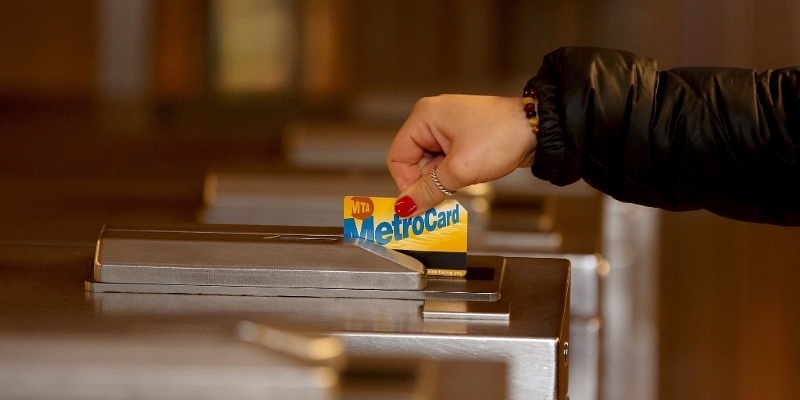Technology
One Year Since DeMo, Cashless Transit Is Still A Distant Dream In India
- After demonetisation, there were high hopes of greater migration towards cashless transit, but not much has happened in these 365 days.

A woman swipes her MetroCard in New York (ANADOLU AGENCY VIA GETTY IMAGES)
Last year, when Prime Minister Narendra Modi announced the government’s decision to scrap Rs 500 and Rs 1,000 notes, there was a lot of optimism about the transition to a cashless society. Among the sectors concerned was transport. Cashless transit in India has largely been a mirage at a pan-India level. However, while demonetisation did give India’s cashless economy a big push forward, it didn’t really do much for transport – especially in urban India. The reason for this is pretty apparent. The note ban targeted high-value currency, and the urban transport sector largely dealt with lower currency notes. Of course, lethargic government transport bodies too, are to blame for the lack of any direction towards going cashless.
In the last one year, very little has happened towards going remotely cashless. Among the various proposals such as the More Card and FASTag, few have seen fruition.
Smart cards and digital wallets
The More Card, originally launched in 2012 in Delhi before disappearing into oblivion, was resurrected in 2015 by the Ministry of Urban Development. In its new avatar, the National Common Mobility Card (NCMC) was meant to be on par with international standards, but it has so far been used only by the Kochi Metro and the Bangalore Metropolitan Transport Corporation (BMTC). The BMTC’s smart card implementation too, has been fraught with many issues. The first roll-out of the card finally was in June this year, but only for students. With a planned launch for the general public in November, the much-delayed project is still nowhere in sight, with the BMTC still saying that it will happen soon.
Among the older transport bodies that went digital, such as the Brihanmumbai Electricity Supply and Transport (BEST) and the Navi Mumbai Municipal Transport (NMMT), progress has been relatively stagnant. BEST introduced cashless payments in 2011 while NMMT introduced app-based ticketing in early 2016. Despite this, Ridlr, the app that sells tickets for BEST and NMMT, indicated a four-fold increase in tickets sold using the app.
The Pune Mahanagar Parivahan Mahamandal Limited (PMPML) did start rolling out its Mobile Integration (MI) Card as an integrated card for buses and the upcoming metro, but it is still in the implementation stages.
An integrated smart card (the NCMC) for buses, trains, ferries, tolls and metro rail – which the More Card was envisioned as – is still nowhere on the horizon; commuters in Mumbai still have to carry separate cards for BEST, the metro, the monorail and the suburban rail.
Electronic toll collection
Another crucial component in the cashless transit sphere, electronic toll collection (ETC) also has failed to take off. In the months following the note swap, toll collection was temporarily suspended and when the suspension was lifted, there was little change. Some toll plazas were to enable payments using mobile wallets like Paytm and Mobikwik, while the bulk of them went to offer the cumbersome solution of providing a credit card machine.
The government’s FASTag, a radio-frequency ID tag fixed to a vehicle, was meant to solve the country’s toll woes. However, three years after its roll-out, it is still not where it should be. Less than 400 toll plazas are part of the FASTag network and not all toll plazas among these have a functional system in place. State highways are still largely out of the scope of toll plazas, while municipal tolls are nowhere to be seen on the ETC grid. With the government mandating all new vehicles to have a FASTag on them from next month, things might change for the better, but a true cashless drive will only be possible when FASTag’s scope is extended beyond tolls on national highways.
Further, getting a FASTag is still an arduous task and the system reeks of bureaucratic incompetency in spite of private participation in the sector. When getting onto the system is so difficult, why would anyone bother to go digital? FASTag as a system may have progressed more than the More Card, but the progress made still leaves us wanting more.
Overall, the situation today is more or less the same as last year, with not much progress. After demonetisation, there were high hopes of greater migration towards cashless transit, but not much has happened in these 365 days.
Introducing ElectionsHQ + 50 Ground Reports Project
The 2024 elections might seem easy to guess, but there are some important questions that shouldn't be missed.
Do freebies still sway voters? Do people prioritise infrastructure when voting? How will Punjab vote?
The answers to these questions provide great insights into where we, as a country, are headed in the years to come.
Swarajya is starting a project with an aim to do 50 solid ground stories and a smart commentary service on WhatsApp, a one-of-a-kind. We'd love your support during this election season.
Click below to contribute.
Latest